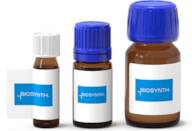
CBL-B (22-37) Heavy
Ref. 3D-CRB1300943
| 25nMol | 452.00 € |
Product Information
- H-ILGIIDAIQDAVGPPK^-OHILGIIDAIQDAVGPP-[U-13C6,15N2-Lys]-acidH-Ile-Leu-Gly-Ile-Ile-Asp-Ala-Ile-Gln-Asp-Ala-Val-Gly-Pro-Pro-[U-13C6
- 15N2-Lys]-OH
CBL-B (22-37) is derived from the CBL-B E3 ubiquitin ligase which targets receptor tyrosine kinases to lysosome degradation. CBL-B and its family member CBL are expressed in hematopoietic cells and as E3 ubiquitin ligases they contain a tyrosine kinase domain and an RF domain joined by a linker domain. The function of the RF domain is to transfer ubiquitin from E2 ubiquitin-conjugating enzymes onto the target protein which is often phosphorylated. Consequently the ubiquitinated substrate, the receptor tyrosine kinases, are ultimately targeted to the lysosome for degradation.EGFR is an example of a receptor tyrosine kinase whose activation is prevented by CBL and CBL-B when they bind and recruit GRb2, the adapter protein to EGFR. Consequently the ubiquitinylation of EGFR occurs and targets it for recognition by the endosomal protein complex and then lysosome degradation.It has also been found that the CBL family can negatively regulate through ubiquitinylation, PI 3-kinases, Rap G-protein guanine nucleotide exchange factor (GEF), C3G and Rho GTPase GEF Vav which are all non-receptors.If CBL or CBL-B becomes non-functional it can be associated with malignancies such as acute mye-loid leukemia and myelodysplastic syndrome.The lysine residue at position 16 is isotopically labelled with carbon-13 (6) and nitrogen-15 (2).
Chemical properties
Technical inquiry about: 3D-CRB1300943 CBL-B (22-37) Heavy
If you want to request a quotation or place an order, please instead add the desired products to your cart and then request a quotation or order from the cart. It is faster, cheaper, and you will be able to benefit from the available discounts and other advantages.





